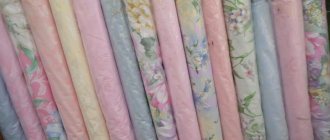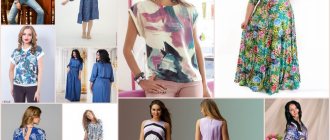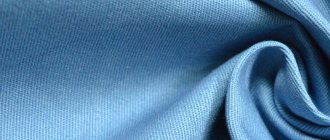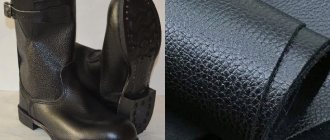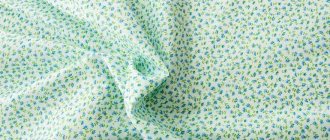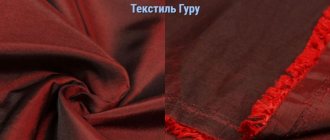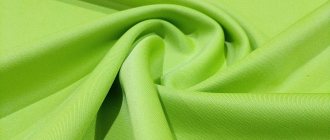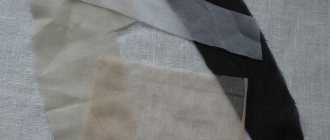| What is it called differently: | viscose, rayon, rayon |
| Natural or synthetic? | artificial |
| How does it feel? | soft, durable, elastic |
| Application: | clothing (dresses, blouses, summer trousers), light blankets, bedspreads, curtains, children's clothes, toys, towels, pillowcases, stockings, socks, underwear, bed linen, outerwear |
| Fabric structure: | simple (smooth or main) weave, satin (satin) spinning |
| Does it stretch or not? (Extensibility) | stretchable fabric |
| Recommended washing temperature: | +30—40 ⁰С |
| Washing mode: | delicate |
| Press: | for 10 minutes at minimum speed |
| Kinds: | modal, bamboo, flowing rayon, lyocell |
| Presence of shine: | shiny material |
| Degree of creasing: | wrinkles a lot |
| Edge fraying: | crumbles a lot |
| Hygroscopicity: | above average |
| Drapability: | excellent |
| Ability to keep warm: | good or low depending on variety |
| Shrinkage: | deforms if not cared for properly |
| Breathability: | sufficient |
| Fade or not: | color fast fabric |
When choosing a blouse in an online store and carefully studying the characteristics of the fabric, not every fashionista will decipher the designation “100% rayon” in the composition column. What kind of material is this, natural or artificial? In fact, everything is simple, and the more common name for rayon fabric is viscose, or “artificial silk.”
Description
Rayon is an artificial fabric made from natural wood raw materials or cellulose. Twill, crepe, knitted, satin and silk weaving are used to join threads into fabric. Modern technologies make it possible to give the material the texture of linen or wool, as well as change the density.
The fabric is pleasant to the touch and can be draped. When incorporated into acetate or polyester, a distinct satin sheen appears. The most attractive fabrics are made from viscose with natural silk. They have a matte or velvety surface with satin fragments or a relief pattern. A variety of shades, patterns and textures can be seen in the photo.
The name rayon comes from the word ray (ray) or bright, colorful. The ending on indicates cotton and the natural origin of the fabric. Read as "district" or "rayon".
Features of using fabric rayon in bed linen
The advantages of the fabric, which will be discussed further, allow the material to be used in the manufacture of beautiful curtains, bed linen and other bedroom accessories.
- Increased thermal conductivity - the material perfectly transmits and retains heat.
- Breathability – textiles from the region do not interfere with the free circulation of air.
- Hygroscopicity - viscose silk absorbs moisture much better than linen and cotton fabrics.
- Wear resistance and strength - in these parameters, viscose silk competes with natural cotton, linen, and silk. However, it must be taken into account that a wet canvas significantly loses its strength indicators. Although after it dries, the strength is restored to its previous values.
- Elasticity - this indicator is higher than that of linen and cotton fabrics, but lower than that of wool and silk.
- Color fastness – brightly and durablely colored textiles do not fade or fade with frequent washing.
It is not difficult to care for bed linen made from rayon fabric, which is highly smooth and resistant to stains. When used in white rayon bedding sets, no special bleaches are required. As a last resort, you can use a bleach containing sodium perborate, sodium hydrochloride or hydrogen peroxide.
Storing products made from viscose silk is easy: the fabric is resistant to harmful microorganisms, moths, dust mites and mold.
History of appearance
The beginning of the material begins in the middle of the 19th century. At this time, in England, J. Mercer first described the process of regenerating an aqueous solution of cellulose, which was used industrially in 1957. In 1892, they learned how to convert the solution into viscose fiber, which became the raw material for rayon. Mass distribution of the material began in 1924 from the USA, where it was called artificial silk.
Production
The production process consists of two stages. First, wood pulp is obtained. To do this, the crushed material is boiled for 24 hours in calcium hydrosulfite. Then the mass is diluted with water, dried on a conveyor belt and cut into layers. After several cycles of chemical treatment, the composition becomes suitable for creating a spinning solution.
In the second stage, cellulose anthogenate is transformed into viscose yarn. The technology involves treatment with caustic soda, then with carbon disulfide to create a viscous spinning solution. It is forced under pressure through a steel plate with holes called a die. Thin streams of substance come out of it and fall into the acid, turning into viscose fiber, which serves as the basis for manufacturing.
How is Rayon material made?
Real cellulose is used for production, but during the process it is subjected to chemical finishing. Raw materials - remnants of spruce, pine wood, flax or cotton waste.
Material production area
The process consists of the following stages:
- Wet molding - the ester is destroyed in a precipitation bath (a mixture of zinc sulfate, sodium, sulfuric acid). It is passed through a spinning mechanism similar to a shower and released into a tank containing a sulfuric acid solution. The resulting threads or flagella are subjected to drawing, desulfurization, washing, abrasion treatment, drying and cutting.
- Material is created from threads on specialized machines. Depending on the model of the spinning device, the fibers can be arched, round, or flat.
You might be interested in what microfiber fabric is made of: description of the material in bedding and shoes
Note! The fiber is produced colorless or dyed in bulk.
Compound
Rayon consists of natural raw materials that have undergone several levels of chemical processing. Combination with other fibers allows you to impart the desired properties.
The fabric composition of the rayon is presented in several versions:
| Viscose | Polyester |
| 20% | 80% |
| 100% | |
| 80% | 20% |
| 60% | 40% |
Expert opinion
Alyona
Fabric expert and technologist Alena Khlebnikova is ready to answer your questions.
Write to us
An experiment will help you make sure that your choice is correct. It is enough to set fire to a piece of fabric. Rayon smells like burning paper and emits white smoke. If synthetic additives are present, a chemical odor and black smoke will appear.
Properties and characteristics
The fabric has a long history of production and has not lost its popularity, which is explained by its properties as high-quality fabrics. Rayon is superior to viscose in strength and elasticity. The strength of the fiber is 2-4 times lower than that of natural silk. Hygienic characteristics are equal to cotton and linen. The elasticity index is considered average, lower than silk and wool, but higher than that of cotton fabrics. Rayon is able to absorb moisture even better than cotton and linen.
Rayon has a number of undeniable advantages:
- Comfortable to wear.
- Elasticity to withstand fiber tension.
- Air permeability and thermal conductivity, which is important for summer clothing.
- Good ventilation for comfort.
- The smooth surface and special structure resist dirt.
- The canvas is easy to paint and has a shiny sheen.
- Hygienic and hypoallergenic, comparable to cotton and linen.
- Does not fade or fade during use.
Among the disadvantages, users note that natural viscose material wrinkles a lot. The presence of synthetics in the composition eliminates this problem. Products made from rayon can shrink and become deformed if not properly maintained. When cutting, the material slides and shifts, which causes difficulties and inconvenience.
Important! The fabric crumbles and frays along the cuts. This feature must be taken into account when cutting and processing seams.
Areas of use
Rayon produces not only elegant and colorful head scarves and neck scarves, stoles, home textiles, bedspreads, curtains, and sleeping sets. It is widely used in the manufacture of napkins, tires for racing cars, tarpaulin boots, and carpets. In light industry for the production of polyethylene, slightly changing the technical conditions. Silk yarn is sold both in bobbins for the industrial production of knitwear and for hand knitting.
You may be interested in: Use of rubberized fabrics in clothing and for technical needs
Where is Rayon fabric used?
Where is it used?
The fabric is universal. It is where lightness and an elegant look are valued. Rayon is used in the manufacture of flowing dresses and sundresses, blouses, summer skirts and trousers. The material makes delightful pareos, scarves, stoles, scarves and shawls. Rayon with silk fiber is an excellent choice for a luxurious, festive outfit.
It adequately competes with natural fabrics in terms of hygiene. Therefore, it is used for household items and as lining material. The area is suitable for casual wear and elegant, formal wear. Looks great in any incarnation.
Rayon has found application in sewing curtains, bedspreads and curtains, and interior decor. The fabric is also used to make bed linen that is comfortable and pleasant to the skin.
Rayon is valued by fashion designers and designers for its unique properties and structure. The material allows you to sew products of any complexity and style. Folds and draperies lie softly and elegantly, cutouts look delicate and natural, and darts look harmonious.
What are rayon fabrics made from?
Thanks to the impressive characteristics and “versatility” of viscose, it has found application in a wide variety of areas.
- Soft viscose fabric, also called “modal,” is used to make home clothes, light blankets and bedspreads, children’s clothes and toys.
- Bamboo fabric (yes, this is also a type of viscose!) is used to produce home textiles, towels, pillowcases, hosiery and even underwear.
- Casual clothes are made from flowing “artificial silk” - dresses, blouses, summer trousers.
- Another variety of “rayon” - lyocell - has found its application in the manufacture of bed linen. This type of viscose is made from eucalyptus tree fibers, and in general the technology is considered more environmentally friendly.
- Even outerwear is made from denser types of rayon fabric, which do not fade even under the bright rays of the sun.
Thus, every modern person should know what kind of fabric this is denoted by the English word rayon and why such a fabric will give odds to most artificial and even natural materials. Use all the advantages of viscose for your own comfort, but do not forget about the disadvantages.
Care
Important! The material is made on the basis of viscose, so when wet it becomes sensitive to mechanical stress. Properties are completely restored after drying.
Products from the area should be washed carefully.
- The fabric is afraid of high temperatures, so water is used no higher than 30°.
- Type of washing - manual or “delicate” without spinning in a machine.
- You cannot squeeze or twist the rayon.
The fabric is prone to snags. Therefore, it is necessary to avoid contact with burrs and sharp objects.
- To remove moisture, wrap the item in a terry towel and leave for 10 minutes. You can immediately hang it up to let the water drain.
- Dry in a ventilated area without additional heating.
- Iron on the “silk” setting from the reverse side.
Advantages and disadvantages of fabric rayon
This is a beautiful and relatively inexpensive fabric.
Viscose silk has remained a popular material for many years. The demand by buyers is explained by many positive properties.
- Elastic soft fabric fits the body shape well and is pleasant to the touch.
- The material is hygienic. Natural raw materials minimize the possibility of allergic reactions to the fabric.
- The area allows air molecules to pass through well. The human body does not suffer discomfort due to air imbalance.
- The viscose base prevents the formation of static electricity.
- The area has a durable coloring that does not change over time.
- The material, very similar to natural silk, is much cheaper than its natural counterpart.
When using products from the region, you need to remember about the possible shortcomings of the fabric.
- Viscose has little strength when wet. This should be remembered when washing, wringing, drying.
- Rayon, like all viscose fabrics, can fray where it is cut. Sewing masters should work with it carefully.
- Uniform viscose fabrics may shrink slightly. To prevent shrinkage, other threads are sometimes introduced into the fabric.
